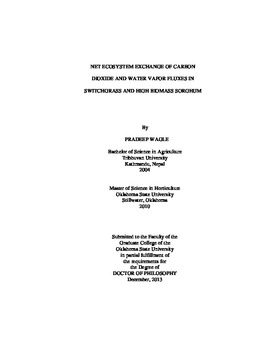| dc.contributor.advisor | Kakani, Vijaya Gopal | |
| dc.contributor.author | Wagle, Pradeep | |
| dc.date.accessioned | 2015-06-17T20:08:22Z | |
| dc.date.available | 2015-06-17T20:08:22Z | |
| dc.date.issued | 2013-12 | |
| dc.identifier.uri | https://hdl.handle.net/11244/15162 | |
| dc.description.abstract | Understanding carbon and water dynamics of switchgrass (Panicum virgatum L.) and high biomass sorghum ((Sorghum bicolor L. Moench) ecosystems is crucial as the acreage of these feedstocks is expanding for cellulosic biofuels. Net ecosystem exchange (NEE) of CO2 and H2O was measured using eddy covariance system over co-located switchgrass and sorghum fields in south central Oklahoma, USA. The major objectives of this study were to quantify and examine seasonal variations in NEE, evapotranspiration (ET), and ecosystem water use efficiency (EWUE) over switchgrass and sorghum ecosystems in response to controlling factors, and to explore the underlying mechanisms. The results revealed photosynthetic photon flux density (PPFD) as the most significant environmental factor for variation in NEE under optimal weather conditions. However, warm air temperature and high vapor pressure deficit (VPD) obscured the NEE-PPFD relationship. Larger VPD (>3 kPa) limited photosynthesis and asymmetrical diurnal NEE cycles were observed in both ecosystems. Consequently, rectangular hyperbolic light-response curve (NEE partitioning algorithm) consistently failed to provide good fits at high VPD. Modified rectangular hyperbolic light-VPD response model accounted for the limitation of VPD on photosynthesis and improved the model performance significantly. The magnitudes of CO2 and H2O fluxes were similar in both ecosystems during the active growing periods and the differences in carbon sink potential and seasonal water demand were primarily driven by the length of the growing season. Monthly ensemble averaged NEE of switchgrass and sorghum reached seasonal peak values of -33.02 +- 1.96 and -35.86 +- 2.32 micromol m-2 s-1, respectively. Similarly, weekly average of daily integrated NEE reached seasonal peaks of -8.5 g C m -2 day-1 in switchgrass and -10.3 g C m-2 day-1 in sorghum. During peak growth, daily ET reached up to 6.2 mm day &minus1 for switchgrass and 6.7 mm day-1 for sorghum. The EWUE was about 12 g CO2 mm-1 ET in switchgrass and about 10 g CO2 mm-1 ET in sorghum. This research showed strong seasonal carbon sink potential and high water use efficiency of both ecosystems in this region. However, evaluation over a longer term would be more valuable. | |
| dc.format | application/pdf | |
| dc.language | en_US | |
| dc.rights | Copyright is held by the author who has granted the Oklahoma State University Library the non-exclusive right to share this material in its institutional repository. Contact Digital Library Services at lib-dls@okstate.edu or 405-744-9161 for the permission policy on the use, reproduction or distribution of this material. | |
| dc.title | Net ecosystem exchange of carbon dioxide and water vapor fluxes in switchgrass and high biomass sorghum | |
| dc.contributor.committeeMember | Ochsner, Tyson E. | |
| dc.contributor.committeeMember | Warren, Jason | |
| dc.contributor.committeeMember | Zou, Chris Bocai | |
| osu.filename | Wagle_okstate_0664D_13046.pdf | |
| osu.accesstype | Open Access | |
| dc.type.genre | Dissertation | |
| dc.type.material | Text | |
| dc.subject.keywords | ecosystem water use efficiency | |
| dc.subject.keywords | eddy covariance | |
| dc.subject.keywords | evapotranspiration | |
| dc.subject.keywords | high biomass sorghum | |
| dc.subject.keywords | net ecosystem exchange | |
| dc.subject.keywords | switchgrass | |
| thesis.degree.discipline | Plant and Soil Sciences | |
| thesis.degree.grantor | Oklahoma State University | |
